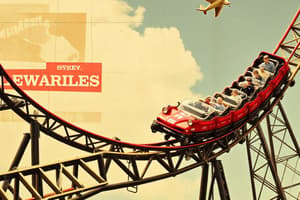Podcast
Questions and Answers
What should students be able to do regarding roller coasters by the end of the lesson?
What should students be able to do regarding roller coasters by the end of the lesson?
- Identify key facts about roller coasters (correct)
- Critique movies that feature roller coasters
- Construct a full-scale roller coaster model
- Design a roller coaster without using any engineering principles
Which material is NOT listed as necessary for the lesson plan?
Which material is NOT listed as necessary for the lesson plan?
- Plastic models of roller coasters (correct)
- Projector or interactive whiteboard
- Books or articles about roller coasters
- Computers or tablets for student research
What is one aspect students might research in their assigned groups?
What is one aspect students might research in their assigned groups?
- The financial losses incurred by amusement parks
- The impact of roller coaster themes on marketing
- The cultural significance of roller coasters (correct)
- The role of roller coasters in social movements
During the lesson, how will students share their findings?
During the lesson, how will students share their findings?
What kind of activity follows the research phase in the lesson plan?
What kind of activity follows the research phase in the lesson plan?
What type of principles should students incorporate into their roller coaster designs?
What type of principles should students incorporate into their roller coaster designs?
What forms the basis of the assessment at the end of the lesson?
What forms the basis of the assessment at the end of the lesson?
Which of these is NOT an objective of the lesson?
Which of these is NOT an objective of the lesson?
Study Notes
Lesson Objectives
- Students will identify key facts about roller coasters worldwide.
- Students will describe the history and evolution of roller coasters.
- Students will analyze the science and engineering behind roller coaster design.
- Students will appreciate the cultural significance and popularity of roller coasters.
Materials Needed
- Projector or interactive whiteboard for presentations.
- Computers or tablets for online research.
- Books or articles about roller coasters for reference.
- Art supplies for creative models or drawings.
Lesson Introduction
- Open the lesson by inviting students to share prior knowledge and experiences with roller coasters.
- Explain the focus of the lesson is on roller coasters globally, including history and scientific principles.
Research Activity
- Divide students into small groups to explore specific aspects of roller coasters:
- The oldest or most famous roller coasters globally.
- The tallest, fastest, or most thrilling roller coasters.
- The underlying science and engineering principles of roller coasters.
- The cultural significance and popularity of roller coasters internationally.
- Allow time for research and note-taking.
Presentation and Discussion
- Each group presents their findings to the class, fostering discussion and questions.
- Facilitate conversation, emphasizing the connections between different researched topics.
Creative Activity
- Provide art supplies for students to design their roller coaster model or drawing.
- Encourage application of design principles learned during research.
- Allow time for sharing and discussing their artistic creations.
Wrap-up and Assessment
- Conclude by reviewing key learning objectives.
- Assess understanding through a short quiz or a brief summary of interesting facts discovered during the lesson.
Studying That Suits You
Use AI to generate personalized quizzes and flashcards to suit your learning preferences.
Description
Test your knowledge about roller coasters from around the globe! This quiz covers key facts, the evolution of roller coasters, their design principles, and their cultural impact. Dive into the thrilling world of roller coasters and discover what makes them so fascinating.




